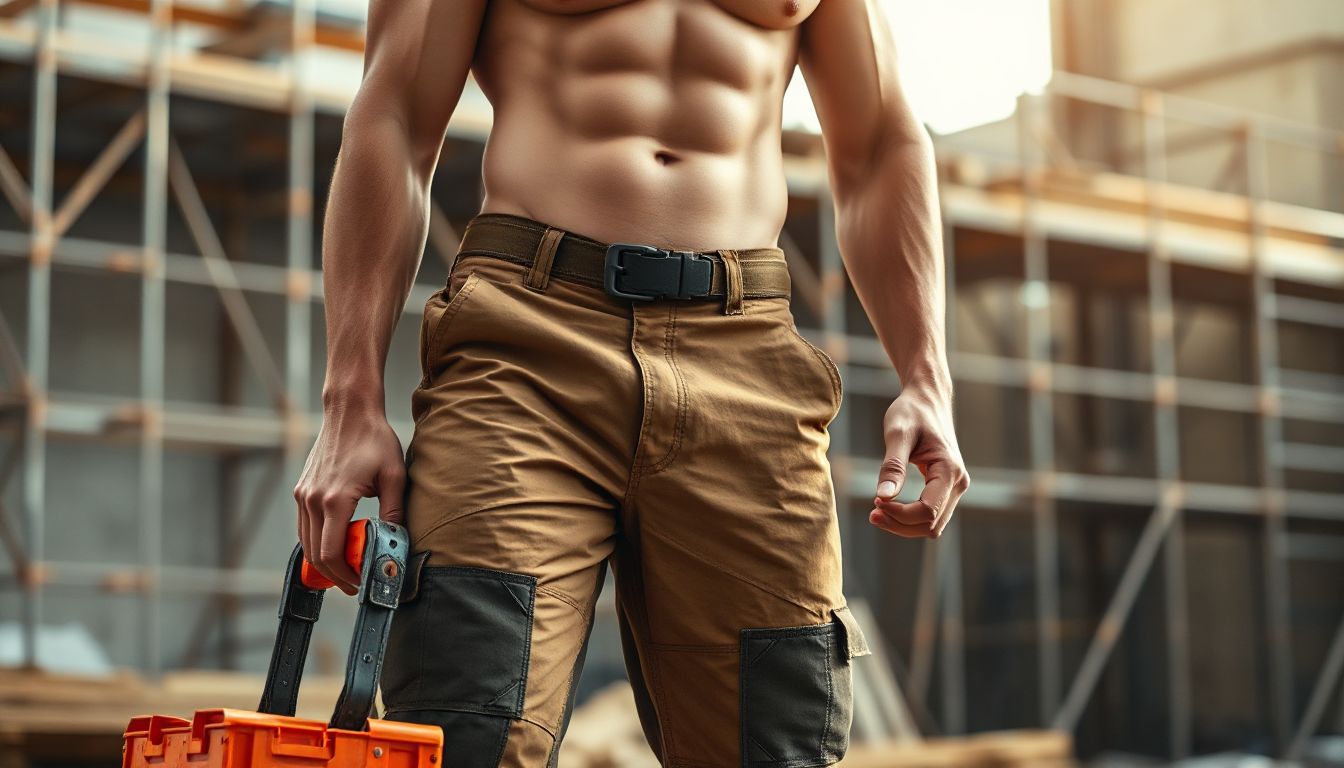Conquer Your Day: The Ultimate Guide to Heavy-Duty Work Pants for Men

Conquer Your Day: The Ultimate Guide to Heavy-Duty Work Pants for Men
You're on the job, kneeling, lifting, and moving, when suddenly – a rip. Your knees wear thin, or discomfort nags you all day. Standard pants simply can't handle the grind. Choosing the right workwear isn't just about looking the part; it's about protecting yourself and getting things done. Your work pants are a critical tool, impacting how productively and safely you can perform your duties.
Think of heavy-duty work pants for men as essential gear, not just clothes. They are purpose-built to stand up to extreme conditions. Investing in quality work trousers pays off. It means less money spent on replacements and more confidence in your gear every single day. These rugged pants are a long-term benefit for any serious professional.
The Anatomy of Tough: What Makes Work Pants Heavy-Duty?
True heavy-duty work pants go beyond thick fabric. They combine specific materials with smart construction. This blend ensures they can take a beating and keep performing. It’s about more than just surviving; it’s about thriving in tough spots.
Fabric Fortitude: Material Matters Most
The core strength of any work pant begins with its material. Tough fibers make all the difference. Picking the right fabric means your pants will endure for years.
Cotton Duck Canvas
Cotton duck canvas is famous for its toughness. This fabric offers great abrasion resistance. It also breathes well, keeping you cooler in warm conditions. You often find it in weights like 10-12 oz, which feels substantial and ready for anything.
Ripstop Nylon/Polyester Blends
Ripstop fabric uses a special weave pattern. This pattern stops tears from spreading, making it incredibly resilient. Blended with nylon or polyester, these pants often offer more flexibility. They also excel at wicking away moisture from your skin.
Reinforced Weaves and Denier Ratings
Denier measures the thickness of individual fibers. A higher denier rating means stronger, more durable threads. Fabrics with reinforced weaves like Cordura® add an extra layer of protection. These materials are built to resist cuts and punctures.
Construction & Reinforcement: Where the Durability Lies
Great fabric needs great construction to perform. Smart design ensures that critical areas don't fail under pressure. This is where attention to detail truly matters.
Triple-Stitched Seams
Triple stitching means three rows of thread hold the fabric together. This extra reinforcement is crucial in high-stress zones. Areas like inseams and outseams benefit most. It's much stronger than standard single or double stitching.
Reinforced Knees and Seats
Workers often spend time kneeling, which quickly wears out pants. Double-layer fabric on the knees offers superior protection. Some designs even include pockets for knee pads. Reinforcing the seat also stops blowouts when bending or squatting.
Gusseted Crotches
A gusseted crotch features an extra piece of fabric sewn into the crotch area. This design significantly improves your freedom of movement. It also reduces stress on the seams, preventing rips during active tasks. You can squat and climb without feeling restricted.
Key Features to Look For in Men's Heavy-Duty Work Pants
Beyond fabric and stitching, specific features boost functionality. These additions turn good pants into great work tools. They help you stay organized and comfortable on the job.
Pockets and Storage: Functionality for the Field
Easy access to your tools saves time and frustration. Well-designed pockets are more than just a place to stash items. They are an extension of your workbench.
Cargo Pockets
Large cargo pockets are perfect for carrying tools, fasteners, or other supplies. Many come with flap closures, keeping your items secure. You'll appreciate the extra space when you need it most.
Tool Loops and Hammer Straps
Dedicated tool loops and hammer straps keep important instruments close by. They stop tools from snagging or getting lost. This feature makes grabbing your hammer or wrench quick and easy.
Reinforced Pocket Bags
Your pockets endure a lot of wear from sharp tools and heavy items. Reinforced pocket bags use stronger materials to prevent premature holes. This keeps your keys and knives from tearing through the fabric.
Fit and Comfort: Toughness Doesn't Mean Stiff
Durability should not come at the cost of comfort. Modern heavy-duty work pants for men offer an impressive balance. You can stay comfortable even during long, demanding shifts.
Articulated Knees
Articulated knees are pre-shaped to mimic your natural bending motion. This design greatly enhances flexibility. It makes squatting, kneeling, and climbing much more comfortable. Your pants move with you, not against you.
Relaxed vs. Straight Fit
Different jobs call for different fits. A relaxed fit provides more room, ideal for layering or lots of movement. A straight fit offers a cleaner look while still providing space. Choose what best suits your daily tasks and preferred style.
Waistband Features
Look for waistbands that offer a secure and comfortable fit. Elasticated sections allow for movement and prevent gapping. Adjustable tabs or a higher back rise can also keep your pants exactly where they should be.
Choosing the Right Heavy-Duty Pants for Your Trade
Every profession has unique demands. Your work pants should match those needs perfectly. Picking the right features ensures you're ready for anything your job throws at you.
Construction and Trades: Building Strength
Construction sites are tough on clothing. Your pants need to handle constant friction and heavy use. They must be as strong as the structures you build.
Demands: High abrasion, kneeling, carrying tools.
Recommended Features: Reinforced knees, ample cargo pockets, durable canvas or ripstop, tool loops.
Real-world example: Carpenters need knee protection and pockets for tape measures. Plumbers appreciate tool loops. Electricians benefit from ripstop fabrics that resist snags.
Landscaping and Outdoor Work: Weathering the Elements
Working outdoors means facing sun, mud, and moisture. Your pants must offer protection and withstand diverse weather. They need to keep you dry and comfortable.
Demands: Durability, water resistance, UV protection, freedom of movement.
Recommended Features: Water-repellent finishes, UV-blocking fabrics, flexible blends, reinforced stress points.
Real-world example: Landscapers need pants that shed water and dirt. Groundskeepers benefit from UV protection during long hours in the sun. Farmers rely on flexible fabrics for active movement.
Industrial and Manufacturing: Safety and Resilience
Factory and warehouse jobs require clothing that endures repetitive motion and potential snags. Comfort is key for long shifts spent standing or moving machinery. Your pants need to be tough yet comfortable.
Demands: Abrasion resistance, potential for snagging, comfort for long shifts.
Recommended Features: Tough synthetic blends, reinforced seams, snag-resistant weaves, ergonomic fit.
Real-world example: Factory workers need snag-resistant pants. Mechanics benefit from oil and grease resistance. Warehouse staff need comfort and durability for constant movement.
Maintenance and Care: Extending the Life of Your Work Pants
Even the toughest heavy-duty work pants need proper care. A little attention goes a long way in making them last. Treat your gear well, and it will serve you longer.
Washing Wisely: Preserving Durability
How you wash your pants impacts their lifespan. Gentle cleaning helps maintain fabric integrity. Harsh methods can break down crucial fibers and coatings.
Washing Temperatures and Detergents
Use cooler water settings when washing your heavy-duty work pants. Cooler water protects fabric fibers from shrinking or degrading. Opt for mild detergents, avoiding harsh chemicals that can strip protective coatings. This keeps your work pants strong.
Avoiding Harsh Treatments
Stay away from fabric softeners, bleach, and high-heat drying. Fabric softeners can clog technical fibers, reducing their performance. Bleach can weaken threads. High heat can damage synthetic materials and cause cotton to shrink prematurely. Air drying is often best.
Repair and Reinforcement: DIY Durability
Small damages don't mean the end for your favorite work pants. A few simple repairs can give them a second life. You can even strengthen them before issues appear.
Patching and Darning
Patching worn areas or small holes can prevent them from growing larger. Use strong, durable fabric for patches. Darning, which involves weaving new thread over a worn spot, also works well. Choose heavy-duty thread for these repairs.
Preemptive Reinforcement
Don't wait for a tear to happen. You can add extra stitching to high-wear areas before they break down. Reinforce seams around pockets or the bottom hem. This small effort can significantly extend the life of your work trousers.
Conclusion: Invest in Your Foundation
Heavy-duty work pants are more than just clothing. They are an essential investment in your daily safety, comfort, and productivity. Choosing the right pair helps you perform better and worry less about wear and tear. These rugged pants are a foundation for your workday.
Remember the critical elements: strong fabrics, robust construction, and specific features. Match these to the demands of your job. Prioritize quality when selecting your next pair of work trousers. Choose pants that will stand strong against any challenge you face.
Find Heavy duty work pants visit Tough Gear | Work Wear for Men



Comments
Post a Comment